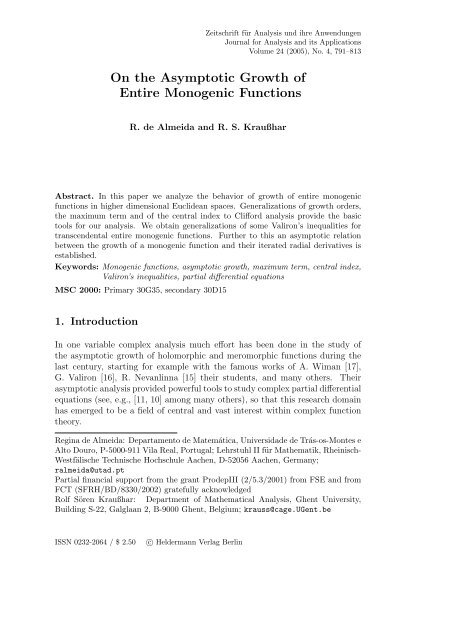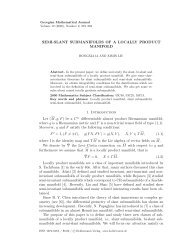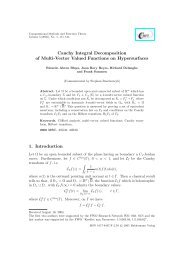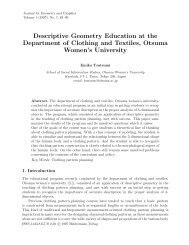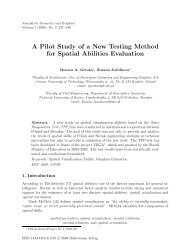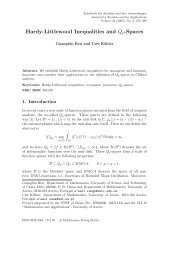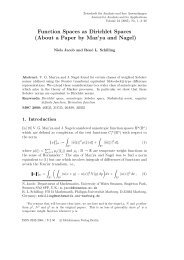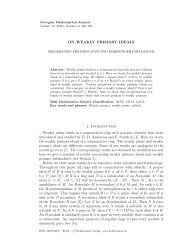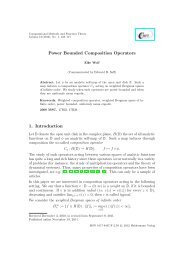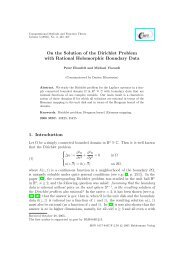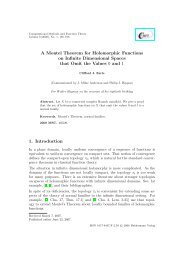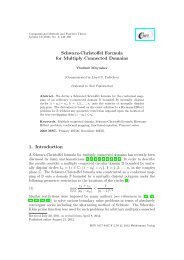On the Asymptotic Growth of Entire Monogenic Functions
On the Asymptotic Growth of Entire Monogenic Functions
On the Asymptotic Growth of Entire Monogenic Functions
Create successful ePaper yourself
Turn your PDF publications into a flip-book with our unique Google optimized e-Paper software.
Zeitschrift für Analysis und ihre Anwendungen<br />
Journal for Analysis and its Applications<br />
Volume 24 (2005), No. 4, 791–813<br />
<strong>On</strong> <strong>the</strong> <strong>Asymptotic</strong> <strong>Growth</strong> <strong>of</strong><br />
<strong>Entire</strong> <strong>Monogenic</strong> <strong>Functions</strong><br />
R. de Almeida and R. S. Kraußhar<br />
Abstract. In this paper we analyze <strong>the</strong> behavior <strong>of</strong> growth <strong>of</strong> entire monogenic<br />
functions in higher dimensional Euclidean spaces. Generalizations <strong>of</strong> growth orders,<br />
<strong>the</strong> maximum term and <strong>of</strong> <strong>the</strong> central index to Clifford analysis provide <strong>the</strong> basic<br />
tools for our analysis. We obtain generalizations <strong>of</strong> some Valiron’s inequalities for<br />
transcendental entire monogenic functions. Fur<strong>the</strong>r to this an asymptotic relation<br />
between <strong>the</strong> growth <strong>of</strong> a monogenic function and <strong>the</strong>ir iterated radial derivatives is<br />
established.<br />
Keywords: <strong>Monogenic</strong> functions, asymptotic growth, maximum term, central index,<br />
Valiron’s inequalities, partial differential equations<br />
MSC 2000: Primary 30G35, secondary 30D15<br />
1. Introduction<br />
In one variable complex analysis much effort has been done in <strong>the</strong> study <strong>of</strong><br />
<strong>the</strong> asymptotic growth <strong>of</strong> holomorphic and meromorphic functions during <strong>the</strong><br />
last century, starting for example with <strong>the</strong> famous works <strong>of</strong> A. Wiman [17],<br />
G. Valiron [16], R. Nevanlinna [15] <strong>the</strong>ir students, and many o<strong>the</strong>rs. Their<br />
asymptotic analysis provided powerful tools to study complex partial differential<br />
equations (see, e.g., [11, 10] among many o<strong>the</strong>rs), so that this research domain<br />
has emerged to be a field <strong>of</strong> central and vast interest within complex function<br />
<strong>the</strong>ory.<br />
Regina de Almeida: Departamento de Matemática, Universidade de Trás-os-Montes e<br />
Alto Douro, P-5000-911 Vila Real, Portugal; Lehrstuhl II für Ma<strong>the</strong>matik, Rheinisch-<br />
Westfälische Technische Hochschule Aachen, D-52056 Aachen, Germany;<br />
ralmeida@utad.pt<br />
Partial financial support from <strong>the</strong> grant ProdepIII (2/5.3/2001) from FSE and from<br />
FCT (SFRH/BD/8330/2002) gratefully acknowledged<br />
Rolf Sören Kraußhar: Department <strong>of</strong> Ma<strong>the</strong>matical Analysis, Ghent University,<br />
Building S-22, Galglaan 2, B-9000 Ghent, Belgium; krauss@cage.UGent.be<br />
ISSN 0232-2064 / $ 2.50<br />
c○ Heldermann Verlag Berlin
792 R. de Almeida and R. S. Kraußhar<br />
Very quickly one observed that a number <strong>of</strong> <strong>the</strong> classical results carry over<br />
relatively easily to <strong>the</strong> framework <strong>of</strong> several complex variables, in particular<br />
many central parts <strong>of</strong> Wiman’s and Valiron’s <strong>the</strong>ory, as illustrated for instance<br />
in <strong>the</strong> textbook [10].<br />
Ano<strong>the</strong>r higher dimensional generalization <strong>of</strong> classical complex analysis is<br />
Clifford analysis, which has been recognized to be a valuable counterpart to several<br />
complex variables <strong>the</strong>ory for tackling higher dimensional problems during<br />
<strong>the</strong> last decades. Clifford analysis considers Clifford algebra valued functions<br />
defined in open subsets <strong>of</strong> R n+1 that satisfy higher dimensional generalizations<br />
<strong>of</strong> <strong>the</strong> Cauchy-Riemann system. This approach opened <strong>the</strong> door to carry over<br />
a number <strong>of</strong> classical and powerful <strong>the</strong>orems from one variable complex analysis<br />
to higher dimensions, such as for instance a Cauchy integral formula, an<br />
argument principle and <strong>the</strong> whole residue and singularity <strong>the</strong>ory. See for instance<br />
[2, 5, 9, 12] among many o<strong>the</strong>r important contributions that point in<br />
this direction.<br />
However, as far as we know, relatively little effort has been done to establish<br />
analogies <strong>of</strong> <strong>the</strong> above indicated asymptotic results within <strong>the</strong> context <strong>of</strong><br />
Clifford analysis so far. In <strong>the</strong> very recent paper [1] some results concerning<br />
<strong>the</strong> asymptotic growth <strong>of</strong> a particular subclass <strong>of</strong> Clifford holomorphic functions<br />
that are built as series from a special family <strong>of</strong> particular polynomials have been<br />
established. However, as <strong>the</strong> main intention in [1] was to describe certain special<br />
Cannon sets <strong>of</strong> that special family <strong>of</strong> Clifford algebra valued functions, many <strong>of</strong><br />
<strong>the</strong> central questions concerning <strong>the</strong> asymptotic analysis remained untouched.<br />
The aim <strong>of</strong> this paper is to fill in some <strong>of</strong> <strong>the</strong>se gaps and to establish some<br />
very first rudiments <strong>of</strong> a generalized Wiman-Valiron <strong>the</strong>ory in <strong>the</strong> context <strong>of</strong><br />
Clifford analysis. Generalizations <strong>of</strong> growth orders, <strong>the</strong> maximum term and <strong>of</strong><br />
<strong>the</strong> central index to Clifford analysis provide <strong>the</strong> basic tools for our analysis.<br />
We obtain generalizations <strong>of</strong> some Valiron’s inequalities for transcendental entire<br />
monogenic functions. Fur<strong>the</strong>r to this an asymptotic relation between <strong>the</strong><br />
maximum term <strong>of</strong> a Clifford holomorphic function and that <strong>of</strong> <strong>the</strong>ir iterated<br />
radial derivatives will be established.<br />
2. Preliminaries<br />
We begin by introducing <strong>the</strong> basic notions and concepts. For detailed information<br />
about Clifford algebras and <strong>the</strong>ir function <strong>the</strong>ory we refer, for example, to<br />
[2, 5] and [9].<br />
2.1. Clifford algebras. By {e 1 , e 2 , . . . , e n } we denote <strong>the</strong> canonical basis <strong>of</strong> <strong>the</strong><br />
Euclidean vector space R n . The attached real Clifford algebra Cl 0n is <strong>the</strong> free<br />
algebra generated by R n modulo <strong>the</strong> relation x 2 = −‖x‖ 2 e 0 , where x ∈ R n and
<strong>Entire</strong> <strong>Monogenic</strong> <strong>Functions</strong> 793<br />
e 0 is <strong>the</strong> neutral element with respect to multiplication <strong>of</strong> <strong>the</strong> Clifford algebra<br />
Cl 0n . In <strong>the</strong> Clifford algebra Cl 0n <strong>the</strong> following multiplication rules hold:<br />
e i e j + e j e i = −2δ ij e 0 , i, j = 1, · · · , n,<br />
where δ ij is <strong>the</strong> Kronecker symbol. A basis for <strong>the</strong> Clifford algebra Cl 0n is given<br />
by <strong>the</strong> set {e A : A ⊆ {1, · · · , n}} with e A = e l1 e l2 · · · e lr , where 1 ≤ l 1 < . . .<br />
< l r ≤ n, e ∅ = e 0 = 1. Each a ∈ Cl 0n can be written in <strong>the</strong> form a = ∑ A a Ae A<br />
with a A ∈ R. Two examples <strong>of</strong> real Clifford algebras are <strong>the</strong> complex number<br />
field C and <strong>the</strong> Hamiltonian skew field H.<br />
The conjugation anti-automorphism in <strong>the</strong> Clifford algebra Cl 0n is defined<br />
by a = ∑ A a Ae A , where e A = e lr e lr−1 · · · e l1 and e j = −e j for j = 1, · · · , n, e 0 =<br />
e 0 = 1. The linear subspace span R {1, e 1 , . . . , e n } = R ⊕ R n ⊂ Cl 0n is <strong>the</strong> socalled<br />
space <strong>of</strong> paravectors z = x 0 + x 1 e 1 + x 2 e 2 + · · · + x n e n which we simply<br />
identify with R n+1 . x 0 =: Sc(z) is called <strong>the</strong> scalar part <strong>of</strong> <strong>the</strong> paravector z and<br />
x := x 1 e 1 + · · · + x n e n =: Vec(z) its vector part.<br />
A scalar product between two Clifford numbers a, b ∈ Cl 0n is defined by<br />
〈a, b〉 := Sc(ab) and <strong>the</strong> Clifford norm <strong>of</strong> an arbitrary a = ∑ A a Ae A is ‖a‖ =<br />
( ∑ A |a A| 2 ) 1 2 . Any paravector z ∈ R n+1 \{0} has an inverse element in R n+1<br />
given by z −1 =<br />
In order to present <strong>the</strong> calculations in a more compact form, <strong>the</strong> following<br />
notations will be used, where m = (m 1 , . . . , m n ) ∈ N n 0 is an n-dimensional<br />
multi-index:<br />
z .<br />
‖z‖ 2<br />
x m := x m 1<br />
1 · · · x mn<br />
n , m! := m 1 ! · · · m n !, |m| := m 1 + · · · + m n .<br />
By τ(i) we denote <strong>the</strong> multi-index (m 1 , . . . , m n ) with m j = δ ij for 1 ≤ j ≤ n.<br />
2.2. Clifford analysis. <strong>On</strong>e way to generalize complex function <strong>the</strong>ory to<br />
higher dimensional hypercomplex spaces is <strong>of</strong>fered by <strong>the</strong> Riemann approach<br />
which considers Clifford algebra valued functions defined in R n+1 that are annihilated<br />
by <strong>the</strong> generalized Cauchy-Riemann operator<br />
D :=<br />
∂<br />
∂x 0<br />
+<br />
n∑<br />
i=1<br />
e i<br />
∂<br />
. (1)<br />
∂x i<br />
If U ⊂ R n+1 is an open set, <strong>the</strong>n a real differentiable function f : U → Cl 0n<br />
is called left (right) monogenic or Clifford holomorphic at a point z ∈ U if<br />
Df(z) = 0 (or fD(z) = 0). <strong>Functions</strong> that are left monogenic in <strong>the</strong> whole<br />
space are also called left entire. The notion <strong>of</strong> left (right) monogenicity in R n+1<br />
provides indeed a powerful generalization <strong>of</strong> <strong>the</strong> concept <strong>of</strong> complex analyticity<br />
to Clifford analysis. Many classical <strong>the</strong>orems from complex analysis could be<br />
generalized to higher dimensions by this approach. We refer, e.g., to [2]. <strong>On</strong>e<br />
central tool is <strong>the</strong> generalized Cauchy integral formula.
794 R. de Almeida and R. S. Kraußhar<br />
Let us denote by A n+1 <strong>the</strong> n-dimensional surface “area” <strong>of</strong> <strong>the</strong> (n + 1)-<br />
dimensional unit ball, and by q 0 (z) = <strong>the</strong> Cauchy kernel function. Then<br />
z<br />
‖z‖ n+1<br />
every function f that is left monogenic in a neighborhood <strong>of</strong> <strong>the</strong> closure D <strong>of</strong> a<br />
domain D satisfies<br />
f(z) = 1 q 0 (z − w) dσ(w) f(w), (2)<br />
A n+1<br />
∫∂D<br />
where dσ(w) is <strong>the</strong> paravector-valued outer normal surface measure, i.e.,<br />
dσ(w) =<br />
n∑<br />
(−1) j e j ̂dwj<br />
j=0<br />
with ̂dw j = dw 0 ∧ · · · ∧ dw i−1 ∧ dw i+1 ∧ · · · ∧ dw n .<br />
It is important to mention that <strong>the</strong> set <strong>of</strong> left (right) monogenic functions<br />
forms only a Clifford right (left) module for n > 1. Ano<strong>the</strong>r important difference<br />
to classical complex function <strong>the</strong>ory is that <strong>the</strong> ordinary powers <strong>of</strong> <strong>the</strong><br />
hypercomplex variable z are not monogenic. In <strong>the</strong> Clifford analysis setting,<br />
<strong>the</strong> complex positive powers are substituted by <strong>the</strong> so-called Fueter polynomials<br />
defined by<br />
P m (z) = 1<br />
|m|!<br />
∑<br />
π∈perm(m)<br />
z π(m1 )z π(m2 ) · · · z π(mn), (3)<br />
where perm(m) denotes <strong>the</strong> set <strong>of</strong> all permutations <strong>of</strong> <strong>the</strong> sequence (m 1 , m 2 , . . . ,<br />
m n ), and z i := x i − x 0 e i for i = 1, . . . , n and P 0 (z) := 1. In this underlying<br />
paper we prefer to work with <strong>the</strong> slightly modified Fueter polynomials<br />
V m (z) := m!P m (z) (4)<br />
which turns out to be more convenient in our calculations.<br />
The negative power functions are generalized by <strong>the</strong> Cauchy kernel function<br />
q 0 (z) and <strong>the</strong>ir partial derivatives<br />
q m (z) =<br />
∂m 0+m 1 +···+m n<br />
∂x m 0<br />
0 ∂x m 1<br />
1 · · · ∂x mn<br />
n<br />
q 0 (z). (5)<br />
In view <strong>of</strong> <strong>the</strong> monogenicity, one can restrict to consider only multi-indices with<br />
m 0 = 0 for many applications. In Taylor- and Laurent expansion <strong>the</strong>orems,<br />
<strong>the</strong>se basic functions <strong>the</strong>n take <strong>the</strong> same role as <strong>the</strong> ordinary powers do in<br />
complex function <strong>the</strong>ory.
<strong>Entire</strong> <strong>Monogenic</strong> <strong>Functions</strong> 795<br />
3. Order <strong>of</strong> growth <strong>of</strong> monogenic functions in R n+1<br />
The starting point for <strong>the</strong> following investigation is that monogenic functions<br />
f : R n+1 → Cl 0n satisfy a maximum principle (cf. [2]). Therefore, <strong>the</strong> function<br />
M(r, f) := M(r) := max{‖f(z)‖}, r ≥ 0 ,<br />
‖z‖=r<br />
is well-defined and strictly monotonic increasing whenever f is non-constant.<br />
Fur<strong>the</strong>rmore, by a direct verification we observe that M is a continuous function.<br />
It is extremely well-known that a complex-analytic polynomial p(z) =<br />
∑ N<br />
n=0 a nz n grows asymptotically like |a N ||z| N . In particular, <strong>the</strong>y exhibit <strong>the</strong><br />
asymptotic |p(z)| ≤ (1 + ε)|a N |r N . The standard monogenic Clifford algebra<br />
valued polynomial functions satisfy very similarly.<br />
Theorem 3.1 (<strong>Asymptotic</strong> growth <strong>of</strong> <strong>the</strong> monogenic polynomials).<br />
Let P (z) = ∑ N<br />
|m|=0 V m(z)a m be a left monogenic polynomial. Then one can find<br />
to every ε > 0 an r 0 > 0 such that for all r = ‖z‖ ≥ r 0<br />
(<br />
)<br />
(n − 1 + N)!<br />
‖P (z)‖ ≤<br />
+ ε ‖a N ‖r N , (6)<br />
(n − 1)!N!<br />
where N is an index with length N such that ‖a N ‖ ≥ ‖a m ‖ for all |m| = N.<br />
Pro<strong>of</strong>. According to, e.g., [6] and [13] we know that<br />
hence ‖V m (z)‖ ≤ ‖z‖ |m| . This leads to<br />
‖P (z)‖ ≤<br />
N∑<br />
|m|=0<br />
‖P m (z)‖ ≤ ‖z‖|m|<br />
,<br />
m!<br />
‖z‖ |m| ‖a m ‖<br />
≤ ‖a N ‖‖z‖ N ( ∑<br />
|m|=N<br />
1 +<br />
= ‖a N ‖r N ( (n − 1 + N)!<br />
(n − 1)!N!<br />
)<br />
‖z‖ |m|−N ‖a m‖<br />
‖a N ‖<br />
)<br />
+ r N (z) ,<br />
N−1<br />
∑<br />
|m|=0<br />
where we set<br />
r N (z) :=<br />
N−1<br />
∑<br />
|m|=0<br />
‖z‖ |m|−N ‖a m‖<br />
‖a N ‖ .
796 R. de Almeida and R. S. Kraußhar<br />
For a sufficiently large r 0 > 0 we observe that |r N (z)| < ε for all ‖z‖ > r 0 , and<br />
<strong>the</strong>refore we infer that for all ‖z‖ > r 0<br />
( )<br />
(n − 1 + N)!<br />
‖P (z)‖ ≤<br />
+ |r N (z)| ‖a N ‖r N<br />
(n − 1)!N!<br />
( )<br />
(n − 1 + N)!<br />
≤<br />
+ ε ‖a N ‖r N .<br />
(n − 1)!N!<br />
As it is well known, <strong>the</strong> maximum principle enables one to immediately<br />
set up a generalization <strong>of</strong> Cauchy’s inequality, see e.g. [2]. Using <strong>the</strong> following<br />
inequalities from [14]<br />
‖q l (z)‖ ‖z‖=r ≤<br />
n(n + 1) · · · (n + |l| − 1)<br />
r |l|+n , (7)<br />
which are proved to be <strong>the</strong> optimal upper bound estimate (cf. [3]), Cauchy’s<br />
inequality can be formulated in <strong>the</strong> following optimal way:<br />
Theorem 3.2. Assume that R > 0. Let B(0, R) := {z ∈ R n+1 | ‖z‖ ≤ R}.<br />
Suppose that g : B(0, R) → Cl 0n is left monogenic with <strong>the</strong> Taylor expansion<br />
g(z) := ∑ +∞<br />
|l|=0 V l(z)a l . Then for all 0 < r < R and all indices l ∈ N n 0<br />
n(n + 1) · · · (n + |l| − 1)<br />
‖a l ‖ ≤ M(r) . (8)<br />
l! r |l|<br />
This follows directly by applying <strong>the</strong> estimate (7) and <strong>the</strong> maximum principle<br />
on <strong>the</strong> well-known representation formula for <strong>the</strong> Taylor coefficients<br />
a l = 1 q l (y)dσ(y)g(y). (9)<br />
l!A n+1<br />
∫∂B(0,r)<br />
Applying <strong>the</strong>se inequalities to (9), <strong>the</strong>n one arrives immediately at <strong>the</strong> stated<br />
result. ¿From Cauchy’s inequality <strong>the</strong> generalization <strong>of</strong> <strong>the</strong> classical Liouville<br />
<strong>the</strong>orem (cf. [4], [7]), stating that every left entire monogenic function that is<br />
bounded in R n+1 is a constant, can be deduced directly.<br />
Cauchy’s inequality permits to also deduce <strong>the</strong> following more general version<br />
<strong>of</strong> Liouville’s <strong>the</strong>orem.<br />
Theorem 3.3. Suppose that g : R n+1 → Cl 0n is left entire (i.e., left monogenic<br />
in <strong>the</strong> whole space R n+1 ). If <strong>the</strong>re exists an index s ∈ N n 0 with |s| > 0 satisfying<br />
<strong>the</strong>n<br />
lim inf<br />
r→∞<br />
M(r)<br />
r |s| = L < ∞, (10)<br />
|s|<br />
∑<br />
g(z) = V l (z)a l . (11)<br />
|l|=0
<strong>Entire</strong> <strong>Monogenic</strong> <strong>Functions</strong> 797<br />
Pro<strong>of</strong>. For a sequence (r i ) i with r i → ∞ we infer by (10) that<br />
M(r i )<br />
r |s|<br />
i<br />
≤ L + 1. (12)<br />
Applying Cauchy’s inequality on <strong>the</strong> Taylor coefficients a l <strong>of</strong> <strong>the</strong> function g(z) =<br />
∑ ∞<br />
|l|=0 V l(z)a l in combination with (12) leads to<br />
‖a l ‖ ≤ 1 l!<br />
n(n + 1) · · · (n + |l| − 1)(L + 1)r|s|−|l| i ,<br />
from which follows that a l = 0 for all l with |l| > |s|.<br />
Remark. We observe that <strong>the</strong> expression<br />
log(M(r, f))<br />
log(r)<br />
(13)<br />
remains bounded if and only if f is a monogenic polynomial, i.e. a function<br />
that can be written in <strong>the</strong> form f(z) = ∑ +s<br />
|l|=0 V l(z)a l , where s is a finite nonnegative<br />
integer. By (13) we thus have characterized monogenic polynomials<br />
by <strong>the</strong> property <strong>of</strong> asymptotic growth.<br />
Next we proceed to introduce <strong>the</strong> notion <strong>of</strong> <strong>the</strong> order <strong>of</strong> growth <strong>of</strong> monogenic<br />
functions. To this end we first introduce <strong>the</strong> plus logarithm (cf. e.g. [10]).<br />
Definition 3.4. Let α ≥ 0. Then <strong>the</strong> plus logarithm is said to be<br />
log + (α) := max{0, log(α)}. (14)<br />
In <strong>the</strong> same way as in <strong>the</strong> planar case (see [10]) one also may introduce<br />
order <strong>of</strong> growth for <strong>the</strong> hypercomplex case (see also [1]).<br />
Definition 3.5. Let g : R n+1 → Cl 0n be a left entire function. Then<br />
ρ(g) := lim sup<br />
r→∞<br />
log + (log + M(r))<br />
, 0 ≤ ρ ≤ ∞ , (15)<br />
log(r)<br />
is called <strong>the</strong> order <strong>of</strong> growth <strong>of</strong> <strong>the</strong> function g. We fur<strong>the</strong>r introduce<br />
λ(g) := lim inf<br />
r→∞<br />
log + (log + M(r))<br />
, 0 ≤ λ ≤ ∞ , (16)<br />
log(r)<br />
as <strong>the</strong> inferior order <strong>of</strong> growth <strong>of</strong> g. If ρ = λ, <strong>the</strong>n we say that g is a function<br />
<strong>of</strong> regular growth. If ρ > λ <strong>the</strong>n g is said to be <strong>of</strong> irregular growth.
798 R. de Almeida and R. S. Kraußhar<br />
Let us start with discussing some particular examples which play a fundamental<br />
role in Clifford analysis. We begin by looking at <strong>the</strong> simplest case where<br />
P (z) is an arbitrary left monogenic polynomial, i.e., <strong>the</strong>re exist Clifford numbers<br />
a n ∈ Cl 0n and N ∈ N 0 such that P (z) = ∑ N<br />
|n|=0 V n(z)a n . From Theorem 3.1<br />
we know that<br />
(<br />
)<br />
(n − 1 + N)!<br />
‖P (z)‖ ≤<br />
+ ε ‖a N ‖r N ,<br />
(n − 1)!N!<br />
where N is <strong>the</strong> index <strong>of</strong> length N for which ‖a N ‖ ≥ ‖a m ‖ for all |m| = N,<br />
with an arbitrarily small ε > 0 for r sufficiently large. Thus, it follows with<br />
C(N) := ( (n−1+N)!<br />
(n−1)!N!<br />
+ ε ) ‖a N ‖ that<br />
log + (log + (M(r, P ))<br />
lim<br />
r→∞ log(r)<br />
≤ lim<br />
r→∞<br />
log + (log + (C(N)r N )<br />
log(r)<br />
= 0 .<br />
Thus, all monogenic polynomials satisfy ρ(P ) = λ(P ) = 0, like in <strong>the</strong> complex<br />
case.<br />
In <strong>the</strong> classical case, <strong>the</strong> exponential function has growth order equal to 1.<br />
We shall now see that <strong>the</strong> different monogenic generalizations considered in<br />
[2, 5, 8] turn out to have <strong>the</strong> same growth behavior.<br />
The monogenic plane wave function from [5]<br />
P (m, z) := (1 + im)e −x 0<br />
e i〈m,x〉 , (17)<br />
where m is an arbitrary fixed vector from <strong>the</strong> (n − 1)-dimensional unit sphere<br />
S n := {x ∈ R n | ‖x‖ = 1}, is left entire and satisfies max ‖z‖=r ‖P (m, z)‖ =<br />
‖1 + im‖e r . Hence, for r > 1 we readily obtain<br />
log ( + log + (M(r, P (m, z)) )<br />
lim<br />
r→∞ log(r)<br />
= lim<br />
r→∞<br />
log + ( log + (‖1 + im‖) + r )<br />
log r<br />
= 1,<br />
i.e., ρ(P (m, z)) = λ(P (m, z)) = 1 for all m ∈ S n .<br />
Also <strong>the</strong> previously introduced monogenic generalization from [2, p. 117]<br />
g(z) = exp(x 0 , x 1 , . . . , x n )<br />
= e x 1+···+x n<br />
(<br />
cos(x 0<br />
√ n) −<br />
1 √n (e 1 + · · · + e n ) sin(x 0<br />
√ n)<br />
)<br />
satisfies ‖g(z)‖ = e x 1+···+x n<br />
≤ e nr . <strong>On</strong> <strong>the</strong> o<strong>the</strong>r hand we know that <strong>the</strong>re must<br />
be a positive real number 0 < c ≤ n with max ‖z‖=r ‖g(z)‖ ≥ e cr . The constant c<br />
needs to be positive, o<strong>the</strong>rwise we would have max ‖z‖=r e x 1+···+x n<br />
= 1 which<br />
would be wrong. Hence,<br />
log ( + log + (M(r, g)) )<br />
log ( + log + (e cr ) )<br />
lim<br />
= lim<br />
= 1,<br />
r→∞ log(r)<br />
r→∞ log(r)
<strong>Entire</strong> <strong>Monogenic</strong> <strong>Functions</strong> 799<br />
with 0 < c ≤ n, so that we get again ρ(g) = λ(g) = 1, analogously to <strong>the</strong><br />
classical case <strong>of</strong> dealing with <strong>the</strong> complex analytic exponential function.<br />
Also <strong>the</strong> very recently introduced R n+1 -valued multiperiodic exponential<br />
function from [8] fits within this scheme. To leave it simple, let us consider this<br />
function in <strong>the</strong> four-dimensional quaternionic case, where it has <strong>the</strong> representation<br />
EXP(x 0 , x 1 , x 2 , x 3 ) = Exp 0 +e 1 Exp 1 +e 2 Exp 2 +e 3 Exp 3 ,<br />
where<br />
Exp 0 (x 0 , x 1 , x 2 , x 3 )<br />
( (<br />
= e x x1<br />
) ( x2<br />
) ( x3<br />
) ( x1<br />
) ( x2<br />
) ( x3<br />
) )<br />
0<br />
cos √ cos √ cos √ − sin √ sin √ sin √<br />
3 3 3 3 3 3<br />
Exp 1 (x 0 , x 1 , x 2 , x 3 )<br />
√ (<br />
= e x 0 3<br />
sin<br />
3<br />
Exp 2 (x 0 , x 1 , x 2 , x 3 )<br />
√ (<br />
= e x 0 3<br />
cos<br />
3<br />
Exp 3 (x 0 , x 1 , x 2 , x 3 )<br />
√ ( 3<br />
sin<br />
= e x 0<br />
3<br />
( x1<br />
√<br />
3<br />
)<br />
cos<br />
( x1<br />
√<br />
3<br />
)<br />
sin<br />
( x1<br />
√<br />
3<br />
)<br />
sin<br />
( x2<br />
) ( x3<br />
) ( x1<br />
) ( x2<br />
) ( x3<br />
) )<br />
√ cos √ + cos √ sin √ sin √<br />
3 3 3 3 3<br />
( x2<br />
) ( x3<br />
) ( x1<br />
) ( x2<br />
) ( x3<br />
) )<br />
√ cos √ + sin √ cos √ sin √<br />
3 3 3 3 3<br />
( x2<br />
) ( x3<br />
) ( x1<br />
) ( x2<br />
) ( x3<br />
) )<br />
√ cos √ + cos √ cos √ sin √ .<br />
3 3 3 3 3<br />
By a direct computation one arrives at<br />
√<br />
3<br />
3 er ≤ max<br />
‖z‖=r ‖ EXP(x 0, x 1 , x 2 , x 3 )‖ ≤ e r ,<br />
hence, once more we obtain,<br />
log ( log ( √<br />
3<br />
1 = lim<br />
er)) 3<br />
r→∞ log(r)<br />
log ( + log + M(r, EXP) )<br />
≤ lim<br />
r→∞ log(r)<br />
log ( log(e r ) )<br />
≤ lim<br />
= 1 .<br />
r→∞ log(r)<br />
After <strong>the</strong> discussion <strong>of</strong> <strong>the</strong>se particular examples, let us now return to <strong>the</strong><br />
more general framework. As a consequence <strong>of</strong> Cauchy’s integral formula we can<br />
establish<br />
Theorem 3.6. Let g be a left entire function in R n+1 . By g i we denote <strong>the</strong><br />
function g i := ∂<br />
∂x i<br />
g and M i (r) := max ‖z‖=r {‖g i (z)‖}, where r > 0 and i ∈<br />
{0, . . . , n}. Then<br />
ρ(g) = ρ ′ (g) and λ(g) = λ ′ (g), (18)
800 R. de Almeida and R. S. Kraußhar<br />
where<br />
ρ ′ (g) := lim sup<br />
r→∞<br />
log + ( log + (M ′ (r)) )<br />
log(r)<br />
for M ′ (r) := max i=0,1,...,n {M i (r)}.<br />
, λ ′ (g) := lim inf<br />
r→∞<br />
log + ( log + (M ′ (r)) )<br />
log(r)<br />
Pro<strong>of</strong>. Let us consider an arbitrary rectifiable curve from <strong>the</strong> origin to z. Then<br />
g(z) = g(0) + ∫ 1 ∑ n<br />
0 i=0 x i g i (tz) dt. For z ∈ R n+1 with ‖z‖ = r we get<br />
n∑<br />
‖g(z)‖ ≤ ‖g(0)‖ + r M i (r) ≤ ‖g(0)‖ + r(n + 1)M ′ (r).<br />
i=0<br />
Therefore we have M(r) ≤ ‖g(0)‖ + r(n + 1)M ′ (r). Applying some properties<br />
<strong>of</strong> log + we obtain<br />
log + (M(r)) ≤ log + (‖g(0)‖) + log + (r(n + 1)) + log + (M ′ (r)) + log(2),<br />
which leads to ρ(g) ≤ ρ ′ (g) and λ(g) ≤ λ ′ (g). To show <strong>the</strong> inequality in <strong>the</strong><br />
o<strong>the</strong>r direction, we apply on g i Cauchy’s integral formula:<br />
g i (z) = 1<br />
q τ(i) (ζ − z)dσ(ζ)g(ζ). (19)<br />
A n+1<br />
∫‖ζ−z‖=R−r<br />
Applying <strong>the</strong> estimate (7) on (19) we hence obtain<br />
‖g i (z)‖ ≤ 1<br />
n<br />
M(R)dS<br />
A n+1<br />
∫‖ζ−z‖=R−r (R − r)<br />
n+1<br />
from which we <strong>the</strong>n may infer M i (r) ≤<br />
max i=0,1,...,n {M i (r)} we have<br />
M ′ (r) ≤<br />
Setting R = 2r in (20) we get M ′ (r) ≤ n M(2r). Thus,<br />
r<br />
n M(R), in particular for M ′ (r) :=<br />
(R−r)<br />
n<br />
M(R). (20)<br />
(R − r)<br />
log + M ′ (r) ≤ log + M(2r) + log + ( n<br />
r<br />
For what follows we may assume without loss <strong>of</strong> generality that r > n. Thus,<br />
log + M ′ (r) ≤ log + M(2r). Hence,<br />
log ( + log + M ′ (r) ) ( ≤ log+ log + M(2r) ) ( = log+ log + M(2r) )<br />
log(2r)<br />
log(r)<br />
log(r)<br />
log(2r) log(r) .<br />
Thus, we have<br />
log + ( log + M ′ (r) )<br />
log(r)<br />
)<br />
.<br />
(<br />
≤ log+ log + M(2r) ) ( ) log 2<br />
log(2r) log(r) + 1<br />
from which we can infer directly that ρ(g) ≥ ρ ′ (g) and λ(g) ≥ λ ′ (g).<br />
,
<strong>Entire</strong> <strong>Monogenic</strong> <strong>Functions</strong> 801<br />
Remark. Computing <strong>the</strong> growth order ρ(f) resp. λ(f) <strong>of</strong> a monogenic function<br />
f, <strong>the</strong>n we automatically know <strong>the</strong> growth order <strong>of</strong> <strong>the</strong> maximum <strong>of</strong> all its<br />
partial derivatives which is <strong>the</strong> same.<br />
Notice that Cauchy’s integral formula was <strong>the</strong> fundamental ingredient to establish<br />
this result. It is thus indeed indispensable to work in classes <strong>of</strong> functions<br />
that are in <strong>the</strong> kernel <strong>of</strong> a differential operator that satisfy a Cauchy type integral<br />
formula. The class <strong>of</strong> monogenic functions provides us with <strong>the</strong> canonical<br />
and easiest example being endowed with this property.<br />
4. Central indices <strong>of</strong> an entire monogenic function in R n+1<br />
Take a left entire function g(z) = ∑ +∞<br />
|l|=0 V l(z)a l . If g is transcendental, i.e.,<br />
infinitely many a l ≠ 0, <strong>the</strong>n lim |l|→∞ ‖a l ‖r |l| = 0 if one assumes r to be fixed.<br />
Thus, <strong>the</strong> following expression is well-defined.<br />
Definition 4.1. Let g : R n+1 → Cl 0n be a left entire function and let r > 0 be<br />
a fixed real. Then <strong>the</strong> associated maximum term is said to be<br />
We fur<strong>the</strong>r define central indices.<br />
{<br />
µ(r) := µ(r, g) := max ‖al ‖r |l|} . (21)<br />
|l|≥0<br />
Definition 4.2. Let g(z) = ∑ +∞<br />
|l|=p V l(z)a l be a left entire function. For r > 0<br />
<strong>the</strong> index (or <strong>the</strong> indices) m with maximal length |m| with µ(r) = ‖a m ‖r |m| is<br />
(are) called central index (indices) which shall be denoted by ν(r) = ν(r, g) =<br />
m. By ν(0) we denote <strong>the</strong> indices l which satisfy |l| = p.<br />
In a similar way we also can introduce <strong>the</strong>se notions for monogenic polynomials.<br />
For a monogenic polynomial p(z) = ∑ |N|<br />
|l|=0 V l(z)a l , we observe that<br />
µ(r) = ‖a N ‖r |N| (where N is (are) <strong>the</strong> index (indices) <strong>of</strong> length N satisfying<br />
‖a N ‖ ≥ ‖a m ‖ for all |m| = N) and ν(r) = N, provided r is sufficiently large.<br />
The case dealing with transcendental functions is more complicated. We<br />
show<br />
Theorem 4.3. Assume that g : R n+1 → Cl 0n is a left entire transcendental<br />
function. Then<br />
1. µ(r) increases for r ≤ r 0 strictly monotonic and lim r→∞ µ(r) = ∞;<br />
2. |ν(r)| increases monotonic and lim r→∞ |ν(r)| = ∞. Fur<strong>the</strong>rmore, |ν(r)|<br />
is stepwise constant.
802 R. de Almeida and R. S. Kraußhar<br />
Pro<strong>of</strong>. Ad 1. Since g is not a constant function, we can infer that <strong>the</strong>re exists<br />
an r 0 > 0 such that |ν(r)| ≥ 1 for r ≥ r 0 . From <strong>the</strong> definition we can fur<strong>the</strong>r<br />
conclude that for R > r ≥ r 0<br />
µ(r) = ‖a ν(r) ‖r |ν(r)| < ‖a ν(r) ‖R |ν(r)| ≤ ‖a ν(R) ‖R |ν(R)| = µ(R),<br />
thus, µ(r) is strictly monotonic increasing.<br />
Now we consider<br />
lim inf<br />
r→∞<br />
log + (µ(r))<br />
log(r)<br />
≥ lim inf<br />
r→∞<br />
= lim inf<br />
r→∞<br />
= lim inf<br />
r→∞<br />
log(‖a l ‖r |l| )<br />
log(r)<br />
log ‖a l ‖ + |l| log(r)<br />
log(r)<br />
(<br />
)<br />
log ‖a l ‖<br />
log(r) + |l| = |l| ∀ l ∈ N n 0 .<br />
Since g is a transcendental function, i.e., infinitely many a l ≠ 0, it follows that<br />
lim inf<br />
r→∞<br />
log + (µ(r))<br />
log(r)<br />
i.e., µ(r) → ∞ for r → ∞.<br />
Ad 2. For r < R we have <strong>the</strong> two estimates<br />
from which we infer that<br />
= ∞,<br />
‖a ν(R) ‖R |ν(R)| ≥ ‖a ν(r) ‖R |ν(r)|<br />
‖a ν(r) ‖ r |ν(r)| ≥ ‖a ν(R) ‖r |ν(R)|<br />
( R<br />
r<br />
) |ν(R)| ( ) |ν(r)| R<br />
≥ .<br />
r<br />
Thus, |ν(r)| is monotonic increasing.<br />
From lim |l|→∞ a l = 0 we infer that <strong>the</strong>re is a positive constant C such that<br />
µ(r) = ‖a ν(r) ‖r |ν(r)| ≤ Cr |ν(r)| from which<br />
follows. From<br />
log + (µ(r))<br />
log(r)<br />
≤ log(C)<br />
log(r) + |ν(r)|<br />
log + (µ(r))<br />
lim<br />
r→∞ log(r)<br />
= ∞<br />
we conclude fur<strong>the</strong>r that lim r→∞ |ν(r)| = ∞. Since ν(r) ∈ N n 0 and since |ν(r)|<br />
tends monotonic to infinity, |ν(r)| has to be stepwise constant having at most<br />
a countable number <strong>of</strong> discontinuities.
<strong>Entire</strong> <strong>Monogenic</strong> <strong>Functions</strong> 803<br />
5. Generalizations <strong>of</strong> some <strong>the</strong>orems from Valiron<br />
to Clifford analysis<br />
In this section we generalize some classical <strong>the</strong>orems from Valiron to Clifford<br />
analysis.<br />
Theorem 5.1. Suppose that g : R n+1 → Cl 0n is a left entire transcendental<br />
function with <strong>the</strong> property that its first Taylor coefficient a 0 ≠ 0. Then<br />
log + (µ(r)) − log ‖a 0 ‖ =<br />
∫ r<br />
0<br />
|ν(t)|<br />
t<br />
dt. (22)<br />
Pro<strong>of</strong>. From <strong>the</strong> hypo<strong>the</strong>sis we know that g(z) = ∑ +∞<br />
|l|=0 V l(z)a l where infinitely<br />
many a l ≠ 0, among <strong>the</strong>m <strong>the</strong> first coefficient a 0 = g(0).<br />
First we assume without loss <strong>of</strong> generality that g(0) = 1. If 0 = t 0 < t 1 <<br />
t 2 < . . . are <strong>the</strong> discontinuities <strong>of</strong> |ν(r)|, <strong>the</strong>n we can infer for t j < t < t j+1<br />
that µ(t) = ‖a l ‖t |l| with a fixed l ≡ ν(t). Fur<strong>the</strong>rmore, µ ′ (t) = |l|‖a l ‖t |l|−1 =<br />
|ν(t)|<br />
t<br />
µ(t). Thus, in an interval [0, r] it holds excepted at a finite number <strong>of</strong> points<br />
d { } µ ′ (t)<br />
log(µ(t)) =<br />
dt<br />
µ(t) = |ν(t)| .<br />
t<br />
Since µ(t) is a continuous function, which can be proved in analogy as [10,<br />
Satz 4.2(b)], relying on Theorem 4.3, we can apply <strong>the</strong> main <strong>the</strong>orem <strong>of</strong> differential<br />
and integral calculus:<br />
log(µ(r)) = log(µ(r)) − log(µ(0)) =<br />
∫ r<br />
0<br />
∫<br />
d { } r<br />
|ν(t)|<br />
log(µ(t)) dt = dt .<br />
dt<br />
0 t<br />
From Cauchy’s inequality for monogenic functions (Theorem 3.2) we obtain<br />
immediately <strong>the</strong> estimate<br />
where ν(r) is one central index.<br />
n(n + 1) · · · (n + |ν(r)| − 1)<br />
µ(r) ≤ M(r) , (23)<br />
ν(r)!<br />
Now we want to prove an estimate in <strong>the</strong> opposite direction. The following<br />
<strong>the</strong>orem provides a generalization <strong>of</strong> one <strong>of</strong> <strong>the</strong> classical Valiron <strong>the</strong>orems to<br />
Clifford analysis:<br />
Theorem 5.2. If g : R n+1 → Cl 0n is a left entire function, <strong>the</strong>n for all<br />
0 < r < R<br />
[<br />
M(r) ≤ µ(r) |ν(R)|(1 + |ν(R)|) n−1 +<br />
R ]<br />
. (24)<br />
R − r
804 R. de Almeida and R. S. Kraußhar<br />
Pro<strong>of</strong>. The function g is left entire, thus it can be represented by g(z) =<br />
∑ +∞<br />
|l|=0 V l(z)a l where infinitely many a l ≠ 0, since g is transcendental. From <strong>the</strong><br />
maximum modulus <strong>the</strong>orem for monogenic functions we infer that for 0 < r < R<br />
M(r) ≤<br />
=<br />
≤<br />
+∞∑<br />
|l|=0<br />
|ν(R)|−1<br />
∑<br />
|l|=0<br />
|ν(R)|−1<br />
∑<br />
|l|=0<br />
‖a l ‖r |l|<br />
‖a l ‖r |l| +<br />
µ(r) +<br />
+∞∑<br />
|l|=|ν(R)|<br />
+∞∑<br />
|l|=|ν(R)|<br />
‖a l ‖r |l|<br />
‖a l ‖r |l| .<br />
(25)<br />
In view <strong>of</strong><br />
|ν(R)|−1<br />
∑<br />
|l|=0<br />
1 = ∑ 1 + ∑ 1 + · · · + ∑<br />
1<br />
|l|=0 |l|=1<br />
|l|=|ν(R)|−1<br />
((n − 1) + 1)! [(n − 1) + (|ν(R) − 1)]!<br />
= 1 + + · · · +<br />
(n − 1)! 1!<br />
(n − 1)!(|ν(R)| − 1)!<br />
[ ]<br />
[(n − 1) + |ν(R)| − 1]!<br />
≤ |ν(R)|<br />
(n − 1)!(|ν(R)| − 1)!<br />
where we use that for all n ≥ 1 <strong>the</strong> inequality<br />
(n − 1 + k)!<br />
(n − 1)! k!<br />
≤<br />
(n − 1 + (k + 1))!<br />
(n − 1)!(k + 1)!<br />
holds, which itself can be verified by a straightforward induction over k. Fur<strong>the</strong>r,<br />
[ ]<br />
[(n − 1) + |ν(R)| − 1]!<br />
|ν(R)|<br />
(n − 1)!(|ν(R)| − 1)!<br />
[ ]<br />
(|ν(R)| + n − 2)(|ν(R)| + n − 3) · · · (|ν(R)| + 1)|ν(R)|<br />
= |ν(R)|<br />
(n − 1)!<br />
[ |ν(R)| + n − 2<br />
= |ν(R)|<br />
· |ν(R)| + n − 3 · · · |ν(R)| + 1 · |ν(R)| ]<br />
n − 1 n − 2<br />
2 1<br />
[( )( ) ( )]<br />
≤ |ν(R)|<br />
· · ·<br />
1 + |ν(R)|<br />
n − 1<br />
} {{ }<br />
≤1+|ν(R)|<br />
≤ |ν(R)| [ (1 + |ν(R)|) n−1] .<br />
1 + |ν(R)|<br />
n − 2<br />
} {{ }<br />
≤1+|ν(R)|<br />
1 + |ν(R)|<br />
1 } {{ }<br />
=1+|ν(R)|
<strong>Entire</strong> <strong>Monogenic</strong> <strong>Functions</strong> 805<br />
Inserting <strong>the</strong>se results into (25) leads to<br />
M(r) ≤ µ(r)|ν(R)| [ (1 + |ν(R)|) n−1] +<br />
+∞∑<br />
= µ(r)|ν(R)| [ (1 + |ν(R)|) n−1] + µ(r)<br />
≤ µ(r)|ν(R)| [ (1 + |ν(R)|) n−1] + µ(r)<br />
[<br />
= µ(r) |ν(R)| [ (1 + |ν(R)|) n−1] +<br />
|l|=|ν(R)|<br />
+∞∑<br />
‖a l ‖r |l| ‖a ν(r)‖r |ν(r)| R |l+ν(R)|<br />
‖a ν(R) ‖r |ν(R)| R |l+ν(R)|<br />
|l|=|ν(R)|<br />
+∞∑<br />
R<br />
R − r<br />
|l|=|ν(R)|<br />
]<br />
.<br />
‖a l ‖R |l| R |ν(R)| r |l|<br />
‖a ν(R) ‖R |ν(R)| R |l| r |ν(R)|<br />
( r<br />
R) |l|−|ν(R)|<br />
In complex analysis G. Valiron has proved that an entire complex-analytic<br />
function g <strong>of</strong> finite order shows <strong>the</strong> asymptotic behavior log(M(r))∼log(M ′ (r)),<br />
where M ′ is <strong>the</strong> maximum modulus <strong>of</strong> <strong>the</strong> derivative. The classical pro<strong>of</strong> is<br />
based on <strong>the</strong> fact that one has <strong>the</strong> relation µ(r) ≤ M(r) for complex-analytic<br />
function. In <strong>the</strong> framework <strong>of</strong> working with Clifford algebra valued monogenic<br />
Taylor series built with <strong>the</strong> Fueter polynomials, we have been so far only able to<br />
establish an estimate <strong>of</strong> <strong>the</strong> form µ(r) ≤ n(n+1)···(n+|ν(r)|−1) M(r) for a central index<br />
ν(r) as a consequence <strong>of</strong> Cauchy’s inequalities. Notice that <strong>the</strong> estimate (7)<br />
ν(r)!<br />
has been proven to be sharp. Adapting <strong>the</strong> classical methods based on Cauchy’s<br />
inequality to <strong>the</strong> higher dimensional case provides us only with a slightly weaker<br />
result in <strong>the</strong> Clifford analysis setting. First we show<br />
Proposition 5.3. For a left entire function g : R n+1 → Cl 0n <strong>of</strong> order ρ and<br />
inferior order λ set<br />
ρ 1 := lim sup<br />
r→∞<br />
λ 1 := lim inf<br />
r→∞<br />
log + log + µ(r)<br />
log(r)<br />
log + log + µ(r)<br />
log(r)<br />
Then ρ ≤ ρ 1 = ρ 2 and λ ≤ λ 1 = λ 2 .<br />
, ρ 2 := lim sup<br />
r→∞<br />
, λ 2 := lim inf<br />
r→∞<br />
log + |ν(r)|<br />
log(r)<br />
(26)<br />
log + |ν(r)|<br />
. (27)<br />
log(r)<br />
Pro<strong>of</strong>. The pro<strong>of</strong> that ρ 1 = ρ 2 and λ 1 = λ 2 can be done in complete analogy<br />
to <strong>the</strong> complex case presented in [10, Satz 4.5]. Hence we omit this part.<br />
Let us now show that ρ ≤ ρ 1 . Without loss <strong>of</strong> generality we may restrict to<br />
consider <strong>the</strong> case where ρ 1 < ∞, since <strong>the</strong> assertion is trivial in <strong>the</strong> remaining<br />
case where ρ 1 = ∞. Inserting in particular r = R into Theorem 5.2, leads to<br />
2<br />
M(r) ≤ µ(r) [ |ν(2r)|[1 + |ν(2r)|] n−1 + 2 ] . (28)
806 R. de Almeida and R. S. Kraußhar<br />
In view <strong>of</strong><br />
log |ν(r)|<br />
log(r)<br />
≤ ρ 2 + ε, ε > 0 ,<br />
which equivalently reads |ν(r)| ≤ e (ρ 2+ε) log(r) = r ρ 2+ε , we thus may conclude<br />
that for a sufficiently large r <strong>the</strong>re is an ε 1 > 0 and a δ > 0 such that<br />
M(r) ≤ µ(r) ( |ν(2r)| n (1 + ε 1 ) )<br />
≤ µ(r) ( (2r) n(ρ 2+ε) (1 + ε 1 ) )<br />
Hence with ε 2 := nε + δ we thus have<br />
We thus obtain<br />
log + ( log + M(r) )<br />
log(r)<br />
We thus obtain that<br />
lim sup<br />
r→∞<br />
≤ µ(r)(2r) nρ 2+nε (2r) δ .<br />
M(r) ≤ µ(r)(2r) nρ 2+ε 2<br />
. (29)<br />
≤ log+ log + [ µ(r)(2r) nρ 2+ε 2<br />
]<br />
log(r)<br />
= log+ [ log + µ(r) + log + (2r) nρ 2+ε 2<br />
]<br />
log(r)<br />
≤ log+ ( log + (µ(r)) ) + log + ( log + ((2r) nρ 2+ε 2<br />
) ) + log(2)<br />
log(r)<br />
≤ log+ ( log + µ(r) ) + log + ( (nρ 2 + ε 2 ) log + (2r) ) + log(2)<br />
log(r)<br />
log + ( log + M(r) )<br />
log(r)<br />
≤ lim sup<br />
r→∞<br />
log + ( log + µ(r) )<br />
log(r)<br />
= ρ 1 .<br />
Let us now show that λ ≤ λ 2 (= λ 1 ). If λ 2 = ∞, <strong>the</strong>n <strong>the</strong> assertion is trivial.<br />
Let us thus assume without loss <strong>of</strong> generality that λ 2 < ∞. Then <strong>the</strong>re exists<br />
a sufficiently large R such that log+ |ν(R)|<br />
≤ λ<br />
log R 2 + ε , which equivalently reads<br />
|ν(R)| ≤ R λ 2+ε . (30)<br />
Since <strong>the</strong> Taylor series converges we hence may conclude that we have for sufficiently<br />
large R<br />
µ(R) = ‖a ν(R) ‖R |ν(R)| ≤ R |ν(R)| ≤ R Rλ 2 +ε . (31)<br />
.<br />
Inserting r = R 2<br />
into Theorem 5.2 and applying (30) and (31) thus leads to<br />
M(r) ≤ R Rλ 2 +ε [R nλ 2+nε (1 + ε ′ )] ≤ R Rλ 2 +ε+δ R nλ 2+nε+δ ≤ R Rλ 2 +ε+δ′ ≤ r rλ 2 +ε 1
<strong>Entire</strong> <strong>Monogenic</strong> <strong>Functions</strong> 807<br />
with some appropriate ε ′ , ε ∗ , ε 1 , δ, δ ′ > 0. We finally obtain<br />
log ( + log + M(r) )<br />
log ( + r λ 2+ε 1<br />
log r )<br />
lim inf<br />
≤ lim inf<br />
r→∞ log(r)<br />
r→∞ log(r)<br />
= λ 2 = λ 1 .<br />
Remark. In <strong>the</strong> two-dimensional complex case where we have µ(r) ≤ M(r)<br />
<strong>the</strong>se methods allow one to establish <strong>the</strong> stronger result ρ = ρ 1 = ρ 2 and<br />
λ = λ 1 = λ 2 , as shown for instance in [10, Satz 4.5].<br />
With this proposition we may now establish <strong>the</strong> following <strong>the</strong>orem which<br />
provides us with a weaker analogy <strong>of</strong> Valiron’s asymptotic result on <strong>the</strong> growth<br />
<strong>of</strong> <strong>the</strong> logarithm <strong>of</strong> <strong>the</strong> derivative <strong>of</strong> a given analytic function.<br />
Theorem 5.4. If g : R n+1 → Cl 0n is left entire with ρ 2 (g) < ∞, <strong>the</strong>n<br />
lim sup<br />
r→∞<br />
where M i (r) := max ‖z‖=r<br />
{∥ ∥ ∂<br />
∂x i<br />
g(z) ∥ ∥ } for i = 1, . . . , n.<br />
log M i (r)<br />
log µ(r) ≤ 1 , (32)<br />
Pro<strong>of</strong>. Since g is left entire, we have g(z) = ∑ +∞<br />
|m|=0 V m(z)a m in <strong>the</strong> whole<br />
space R n+1 , hence so is<br />
g i (z) :=<br />
∂<br />
∂x i<br />
g(z) =<br />
Therefore, we obtain for ‖z‖ = r<br />
‖g i (z)‖ ≤<br />
=<br />
+∞∑<br />
|m|=1<br />
+∞∑<br />
|m|=0<br />
+∞∑<br />
|m|=1<br />
∂<br />
∂x i<br />
V m (z)a m<br />
m!<br />
(m − τ(i))! V m−τ(i)(z)a m .<br />
m!<br />
(m − τ(i))! ‖a m‖ r |m−τ(i)| . (33)<br />
In what follows let us denote by µ i <strong>the</strong> maximum term <strong>of</strong> g i and similarly by ν i<br />
<strong>the</strong> central indices <strong>of</strong> g i . If µ(r) = ‖a m ‖r |m| , <strong>the</strong>n m = ν(r) and hence we can<br />
conclude that<br />
µ i (r) ≤ ‖a ν(r) ‖r |ν(r)|−1 |ν(r)| = µ(r) 1 |ν(r)| . (34)<br />
r<br />
In view <strong>of</strong> |ν(r)| = |ν i (r)| + 1 we thus may infer that<br />
lim sup<br />
r→∞<br />
log + (|ν i (r)| + 1)<br />
log(r)<br />
= lim sup<br />
r→∞<br />
log + |ν(r)|<br />
log(r)<br />
=: ρ 2 .
808 R. de Almeida and R. S. Kraußhar<br />
Fur<strong>the</strong>r to this we have for ε > 0 that |ν i (r)| ≤ |ν i (r)| + 1 ≤ r ρ 2+ε . Applying<br />
Theorem 5.2 and <strong>the</strong> same arguments as in <strong>the</strong> pro<strong>of</strong> <strong>of</strong> Proposition 5.3, for<br />
ε 1 > 0 we finally arrive at<br />
M i (r) ≤ µ i (r)r nρ 2+ε 1<br />
(34)<br />
≤ µ(r)|ν(r)|r nρ 2+ε 1 −1 ≤ µ(r)r (n+1)ρ 2+ε 1 +ε−1 ,<br />
since |ν(r)| < r ρ 2+ε . Finally, putting δ 1 := ε 1 + ε this <strong>the</strong>n leads to<br />
log M i (r) ≤ log µ(r) + log r (n+1)ρ 2+δ 1 −1<br />
which permits us to conclude that<br />
lim sup<br />
r→∞<br />
log M i (r)<br />
log µ(r)<br />
= log µ(r) + [(n + 1)ρ 2 + δ 1 − 1] log r,<br />
≤ lim sup<br />
r→∞<br />
(<br />
1 +<br />
6. Action <strong>of</strong> iterated Euler operators<br />
(<br />
) ) log r<br />
(n + 1)ρ 2 + δ 1 − 1<br />
= 1 .<br />
log µ(r)<br />
In this section we want to establish a relation between <strong>the</strong> asymptotic behavior<br />
<strong>of</strong> <strong>the</strong> maximum term <strong>of</strong> a monogenic function and that <strong>of</strong> <strong>the</strong>ir iterated radial<br />
derivatives. To proceed in this direction we first establish some preparatory<br />
propositions.<br />
In what follows in this section we will sometimes write for convenience<br />
ν := ν(r) = ν(r, g) for a left entire function g : R n+1 → Cl 0n in cases when no<br />
ambiguity can occur.<br />
Proposition 6.1. Let g be a transcendental left entire monogenic function.<br />
Then<br />
M(r, g) ≤ µ(r)L(r), (35)<br />
where<br />
L(r) :=<br />
((n − 1) + |ν|)!<br />
(n − 1)!|ν|!<br />
+<br />
|ν|−1<br />
∑<br />
|l|=0<br />
‖a l ‖<br />
‖a ν ‖ r|l|−|ν| +<br />
+∞∑<br />
|l|=|ν|+1<br />
‖a l ‖<br />
‖a ν ‖ r|l|−|ν| .<br />
Pro<strong>of</strong>. Since g is a transcendental left entire monogenic function it has a Taylor<br />
∑<br />
expansion (with infinitely many non-vanishing terms) <strong>of</strong> <strong>the</strong> form g(z) =<br />
+∞<br />
|l|=0 V l(z)a l . We have ‖g(z)‖ ≤ ∑ +∞<br />
|l|=0 ‖V l(z)‖‖a l ‖ ≤ ∑ +∞<br />
|l|=0 r|l| ‖a l ‖ for<br />
‖z‖ = r. Since g is transcendental, <strong>the</strong>re exists k ∈ N n 0 such that a k ≠ 0.<br />
Then<br />
‖g(z)‖ ≤ r |k| ‖a k ‖<br />
[ ∑<br />
|l|=|k|<br />
|k|−1<br />
‖a l ‖<br />
‖a k ‖ + ∑ ‖a l ‖<br />
‖a k ‖ r|l|−|k| +<br />
|l|=0<br />
+∞∑<br />
|l|=|k|+1<br />
]<br />
‖a l ‖<br />
‖a k ‖ r|l|−|k| .<br />
Taking in particular k = ν(r) and involve µ(r) = ‖a k ‖r |k| , <strong>the</strong>n one arrives at<br />
<strong>the</strong> stated result.
In order to proceed we need <strong>the</strong> following<br />
<strong>Entire</strong> <strong>Monogenic</strong> <strong>Functions</strong> 809<br />
Proposition 6.2. Let (P k ) k∈N be a sequence <strong>of</strong> real positives satisfying 1 <<br />
P 1 < P 2 < . . . and lim<br />
k→∞<br />
P k = P < ∞. Then <strong>the</strong>re exists a real r > 0 such that<br />
‖a ν−j ‖r |ν|−|j|<br />
‖a ν ‖r |ν|<br />
≤<br />
∏|ν|<br />
P i<br />
i=|ν|−|j|+1<br />
P |j|<br />
|ν|<br />
, |j| = 1, . . . , |ν| (36)<br />
‖a ν+j ‖r |ν+j|<br />
< P |j|<br />
|ν|<br />
, |j| = 1, 2, 3, . . . . (37)<br />
‖a ν ‖r |ν| |ν+j|<br />
∏<br />
P i<br />
i=|ν|+1<br />
The pro<strong>of</strong> can be done in complete analogy to <strong>the</strong> classical pro<strong>of</strong> <strong>of</strong> from [10,<br />
Hilfsatz 21.], p. 189, simply by replacing <strong>the</strong> auxiliary function H(z) defined on<br />
p. 190, equation (21.9), by<br />
H(z) =<br />
+∞∑<br />
|n|=0<br />
( ∏|n|<br />
V n (z)a n P i<br />
).<br />
i=1<br />
The rest <strong>of</strong> <strong>the</strong> pro<strong>of</strong> can <strong>the</strong>n be carried over directly.<br />
Fur<strong>the</strong>r to this we require<br />
Proposition 6.3. For a given ε > 0 we have<br />
L ∗ (r) < |ν(r)| 1 2 +ε , r ∉ F (38)<br />
|ν(r)| < (log µ(r)) 1+ε , r ∉ F , (39)<br />
where L ∗ (r) := L(r) − ( ((n−1)+|ν|)!<br />
− 1 ) and F denotes a set <strong>of</strong> finite logarithmic<br />
(n−1)!|ν|!<br />
measure.<br />
and also<br />
Proposition 6.4. For ε > 0, k ′ , l ∈ N, k ∈ N 0 and m ∈ N n 0 one has<br />
+∞∑<br />
[j]=−|ν|<br />
+∞∑<br />
[j]=[m−ν]<br />
( ) k ′<br />
|j|<br />
‖a ν+j ‖r [ν+j] < µ(r)|ν(r)| 1−k′<br />
2 +ε , r ∉ F (40)<br />
|ν|<br />
|[j]| k<br />
|ν| k+l ‖a ν+j‖r [j+ν] < µ(r)|ν(r)| − 1 2 +ε , r ∉ F . (41)
810 R. de Almeida and R. S. Kraußhar<br />
Here, <strong>the</strong> notation [j] means [j] = ∑ n<br />
i=1 j i. Notice that <strong>the</strong> first indices j<br />
appearing in this sum are elements from −N n 0. The expression [j] coincides with<br />
<strong>the</strong> previously introduced length <strong>of</strong> an index for all j ∈ N n 0.<br />
Using Proposition 6.2 one can prove <strong>the</strong>se propositions in an analogous way<br />
as <strong>the</strong>ir counterparts from <strong>the</strong> complex analysis setting presented in Satz 21.1,<br />
Satz 21.2, and in Hilfssatz 21.2 and Hilfssatz 21.3 from [10], respectively. These<br />
propositions enable us to establish <strong>the</strong> main <strong>the</strong>orem <strong>of</strong> this section.<br />
Theorem 6.5. Let g : R n+1 → Cl 0n be a left entire function. Then for all<br />
k ∈ N holds asymptotically<br />
∥<br />
1<br />
|ν(r)| k [Ek ]g(z) − g(z) ∥ ≤ Cµ(r)|ν(r)|<br />
− 1 2 +ε , r ∉ F, (42)<br />
where E := ∑ n<br />
i=0 x i ∂<br />
∂x i<br />
is <strong>the</strong> Euler operator on R n+1 , C is a real positive<br />
constant and F is a set <strong>of</strong> finite logarithmic measure.<br />
Pro<strong>of</strong>. To show this result, we start to consider<br />
1<br />
|ν| k [ n∑<br />
i=0<br />
x i<br />
] k<br />
∂<br />
g(z) − g(z)<br />
∂x i<br />
= 1<br />
|ν| k<br />
+∞<br />
∑<br />
|m|=1<br />
= −a 0 + 1<br />
|ν| k [ +∞<br />
∑<br />
|m| k V m (z)a m −<br />
|m|=1<br />
|m|=[j]+|ν|<br />
= −a 0 + 1<br />
|ν| k [<br />
= −a 0 + 1<br />
|ν| k<br />
= −a 0 +<br />
= −a 0 +<br />
+∞∑<br />
+∞<br />
∑<br />
+∞∑<br />
|m|=0<br />
V m (z)a m<br />
(|m| k − |ν| k )V m (z)a m<br />
]<br />
+∞<br />
∑<br />
[j]=1−|ν|<br />
( ) k<br />
[j] + |ν| − |ν|<br />
k]<br />
V j+ν (z)a j+ν<br />
)<br />
− |ν| k )<br />
( k∑ ( k<br />
[j] s |ν| k−s s<br />
[j]=1−|ν| s=0<br />
k∑<br />
( ) k<br />
[j] s |ν| −s V j+ν (z)a j+ν<br />
s<br />
[j]=1−|ν| s=1<br />
+∞∑<br />
k∑<br />
[j]=1−|ν| s=1<br />
Let us now estimate <strong>the</strong> expression<br />
S s (z) =<br />
+∞∑<br />
[j]=1−|ν|<br />
|ν| −s P s ([j]) V<br />
} {{ } j+ν (z)a j+ν .<br />
:=[j] s ( k s)<br />
V j+ν (z)a j+ν<br />
|ν| −s P s ([j])V j+ν (z)a j+ν . (43)
<strong>Entire</strong> <strong>Monogenic</strong> <strong>Functions</strong> 811<br />
Taking ‖z‖ = r > 0, we have<br />
We thus have<br />
‖S s (z)‖ ≤<br />
≤<br />
=<br />
‖S s (z)‖ ≤<br />
+∞∑<br />
[j]=1−|ν|<br />
+∞∑<br />
[j]=1−|ν|<br />
+∞∑<br />
[j]=1−|ν|<br />
k!<br />
(k − s)!s!<br />
|ν| −s P s (|j|)‖a j+ν ‖‖V j+ν (z)‖<br />
|ν| −s P s (|j|)‖a j+ν ‖r [j+ν]<br />
( ) s |j| k!<br />
|ν| (k − s)!s! ‖a j+ν‖r [j+ν] .<br />
+∞∑<br />
[j]=1−|ν|<br />
( ) s |j|<br />
‖a j+ν ‖r [j+ν] . (44)<br />
|ν|<br />
Applying Proposition 6.4 for <strong>the</strong> particular case l = 0 and |m| = 1 to <strong>the</strong><br />
previous line, we thus obtain<br />
‖S s (z)‖ ≤<br />
Summarizing, we thus obtain<br />
[ n∑ ] k 1 ∂<br />
x<br />
∥|ν| k i g(z) − g(z)<br />
∂x<br />
i=0 i ∥<br />
k!<br />
(k − s)!s! µ(r)|ν(r)|− 1 2 +ε , r ∉ F. (45)<br />
≤ ‖a 0 ‖ +<br />
≤ ‖a 0 ‖ +<br />
k∑<br />
‖S s (z)‖<br />
s=1<br />
k∑<br />
s=1<br />
k!<br />
(k − s)!s! µ(r)|ν(r)|− 1 2 +ε<br />
= ‖a 0 ‖ + (2 k − 1)µ(r)|ν(r)| − 1 2 +ε<br />
r suff. large<br />
≤ Cµ(r)|ν(r)| − 1 2 +ε<br />
for r ∉ F , where C is a positive real constant.<br />
As an application we may set up <strong>the</strong> following<br />
Proposition 6.6. Let 0 < δ < 1 and ‖z‖ be sufficiently large such that for<br />
2<br />
‖z‖ = r, <strong>the</strong> relation<br />
‖g(z)‖ > µ(r)|ν(r)| − 1 2 +δ (46)
812 R. de Almeida and R. S. Kraußhar<br />
is satisfied, where g is assumed to be left entire.<br />
asymptotically<br />
Then for all k ∈ N holds<br />
1<br />
|ν(r)| k [<br />
E<br />
k ] g(z) − g(z) = o(1)g(z), r ∉ F, (47)<br />
where F is again a set <strong>of</strong> finite logarithmic measure.<br />
Pro<strong>of</strong>. Let us now suppose that ‖z‖ = r ∉ F . In view <strong>of</strong> condition (46) we<br />
have<br />
1<br />
[ n∑ ] k 1 ∂<br />
x<br />
‖g(z)‖ ∥|ν(r)| k i g(z) − g(z)<br />
∂x<br />
i=0 i ∥ ≤ C<br />
µ(r) |ν(r)| 1 2 −δ µ(r)|ν(r)| − 1 2 +ε<br />
= C|ν(r)| ε−δ −→ 0 ,<br />
if we choose ε sufficiently small (i.e., ε < δ). In o<strong>the</strong>r words, we indeed have<br />
1<br />
|ν| k [<br />
E<br />
k ] g(z) − g(z) = o(1)g(z) under <strong>the</strong> given condition.<br />
Remark. This statement provides us with a nice analogy in <strong>the</strong> context <strong>of</strong><br />
Clifford analysis <strong>of</strong> <strong>the</strong> classical Satz 21.3 from [10] which states that entire<br />
complex-analytic functions that satisfy ‖g(z)‖ > M(r, g)[ν(r)] − 1 4 +δ have <strong>the</strong><br />
asymptotic behavior<br />
( ) m ν(r) ( )<br />
g (m) (z) = 1 + o(1) g(z).<br />
z<br />
In <strong>the</strong> Clifford analysis setting one thus obtains a similar asymptotic result<br />
when substituting <strong>the</strong> complex operator z d by <strong>the</strong> higher dimensional Euler<br />
dz<br />
operator E.<br />
Acknowledgement. The authors are very thankful to Dr. Denis Constales<br />
(Ghent University) and to Pr<strong>of</strong>. Gerhard Jank (RWTH Aachen) for a number<br />
<strong>of</strong> very fruitful discussions.<br />
References<br />
[1] Abul-ez, M. A. and D. Constales: <strong>On</strong> <strong>the</strong> order <strong>of</strong> basic series representing<br />
Clifford-valued functions. Appl. Math. Comput. 142 (2003)(2-3), 575 – 584.<br />
[2] Brackx, F., Delanghe, R. and F. Sommen: Clifford Analysis. Research Notes<br />
in Ma<strong>the</strong>matics 76. Boston: Pitman 1982.<br />
[3] Constales, D. and R. S. Kraußhar: Representation formulas for <strong>the</strong> general<br />
derivatives <strong>of</strong> <strong>the</strong> fundamental solution <strong>of</strong> <strong>the</strong> Cauchy-Riemann operator<br />
in Clifford Analysis and Applications. Z. Anal. Anwendungen 21 (2002)(3),<br />
579 – 597.
<strong>Entire</strong> <strong>Monogenic</strong> <strong>Functions</strong> 813<br />
[4] Delanghe, R.: <strong>On</strong> regular points and Liouville’s <strong>the</strong>orem for functions with<br />
values in a Clifford algebra. Simon Stevin 44 (1970/71), 55 – 66.<br />
[5] Delanghe, R., Sommen, F. and V. Souček: Clifford Algebra and Spinor Valued<br />
<strong>Functions</strong>. Dordrecht: Kluwer 1992.<br />
[6] Fueter, R.: Die Singularitäten der eindeutigen regulären Funktionen einer<br />
Quaternionenvariablen I. Comment. Math. Helv. 9 (1936)(1), 320 – 334.<br />
[7] Fueter, R.: Funktionen<strong>the</strong>orie im Hyperkomplexen (Lecture notes written and<br />
supplemented by E. Bareiss, Fall Semester 1948/49). Math. Inst. Univ. Zürich<br />
1949.<br />
[8] Gürlebeck, K. and A. Hommel: <strong>On</strong> exponential functions in Clifford analysis<br />
(to appear).<br />
[9] Gürlebeck, K. and W. Sprössig: Quaternionic and Clifford Calculus for Physicists<br />
and Engineers. Chichester: John Wiley & Sons 1997.<br />
[10] Jank, G. and L. Volkmann: Einführung in die Theorie der ganzen und meromorphen<br />
Funktionen mit Anwendungen auf Differentialgleichungen. UTB Wissenschaft.<br />
Basel: Birkhäuser 1985.<br />
[11] Hayman, W. K.: The local growth <strong>of</strong> power series: a survey <strong>of</strong> <strong>the</strong> Wiman-<br />
Valiron method. Can. Math. Bull. 17 (1974), 317 – 358.<br />
[12] Hempfling, T. and R. S. Kraußhar: Order <strong>the</strong>ory for isolated points <strong>of</strong> monogenic<br />
functions. Archiv Math. 80 (2003)(4), 406 – 423.<br />
[13] Kraußhar, R. S.: Eisenstein Series in Clifford Analysis. Aachener Beiträge zur<br />
Ma<strong>the</strong>matik 28. TH Aachen 2000 (Diss.).<br />
[14] Kraußhar, R. S.: <strong>On</strong> a new type <strong>of</strong> Eisenstein series in Clifford analysis.<br />
Z. Anal. Anwendungen 20 (2001)(4), 1007 – 1029.<br />
[15] Nevanlinna, R.: Zur Theorie der meromorphen Funktionen. Acta Math. 46<br />
(1925), 1 – 99.<br />
[16] Valiron, G.: Lectures on <strong>the</strong> General Theory <strong>of</strong> Integral <strong>Functions</strong>. New York:<br />
Chelsea 1949.<br />
[17] Wiman, A.: Über den Zusammenhang zwischen dem Maximalbetrage einer<br />
analytischen Funktion und dem größten Gliede der zugehörigen Taylorschen<br />
Reihe. Acta Math. 37 (1914), 305 – 326.<br />
Received 11.11.2004


